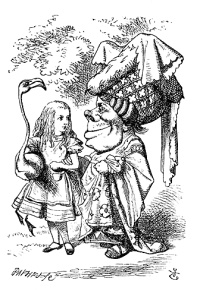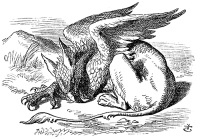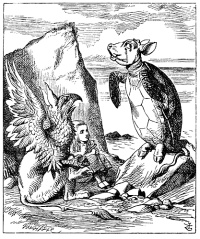The Mock Turtle's Story
Studies in Alice IX, by Marc Edmund Jones This lesson considers the ninth chapter of Alice
in Wonderland and the ninth great principle of
wisdom in the Philosophy of Concepts as
revealed through the adventures of Alice is that
morals and ethics are a matter of fashion and a
product therefore of their times and of the
conditions of their period. In all human conduct
there must be a standard and a background of
action, and while it is perfectly true that nature or
instinct and natural impulse is an initial
controlling agency in human act yet the general
tendency to attribute an inherent intelligence to
all matter and form is equally a weakness of
deistic and mechanistic theories because too
often it is an excuse to avoid the real labor of
tracing natural intelligence to its source. To take
an unlovely but ideal example of the origin of
human and animal conduct in reference to the
sanitary disposal of bodily excrements, it may
superficially be said that the unpleasant odor of
such decomposing matter is given an unpleasant
odor by a natural intelligence to warn life that
such matter is poisonous. All poisons however
do not have a bad odor. Some appear quite seductive to several of the senses simultaneously but
it is to be noted that manure and virtually all fertilizer vital to agriculture are most offensive to
the nostrils. Man's investigation has been improperly directed. The question is not the
explanation of the emanation from the material but the accounting for the fact that it smells
unpleasantly to man. The intelligence is not in the odor but in the sharp distinction between
pure conduct or volitional act and pure reflex action. Conduct gains its value in contrast with
idea, and the development of man has been from the early tribal taboo stage to the present social
insistence on individual good manners. To assume that conduct recognized as moral and ethical
today will be so tomorrow is to assume that all progress of man as a social entity is at an end.
This lesson considers the ninth chapter of Alice
in Wonderland and the ninth great principle of
wisdom in the Philosophy of Concepts as
revealed through the adventures of Alice is that
morals and ethics are a matter of fashion and a
product therefore of their times and of the
conditions of their period. In all human conduct
there must be a standard and a background of
action, and while it is perfectly true that nature or
instinct and natural impulse is an initial
controlling agency in human act yet the general
tendency to attribute an inherent intelligence to
all matter and form is equally a weakness of
deistic and mechanistic theories because too
often it is an excuse to avoid the real labor of
tracing natural intelligence to its source. To take
an unlovely but ideal example of the origin of
human and animal conduct in reference to the
sanitary disposal of bodily excrements, it may
superficially be said that the unpleasant odor of
such decomposing matter is given an unpleasant
odor by a natural intelligence to warn life that
such matter is poisonous. All poisons however
do not have a bad odor. Some appear quite seductive to several of the senses simultaneously but
it is to be noted that manure and virtually all fertilizer vital to agriculture are most offensive to
the nostrils. Man's investigation has been improperly directed. The question is not the
explanation of the emanation from the material but the accounting for the fact that it smells
unpleasantly to man. The intelligence is not in the odor but in the sharp distinction between
pure conduct or volitional act and pure reflex action. Conduct gains its value in contrast with
idea, and the development of man has been from the early tribal taboo stage to the present social
insistence on individual good manners. To assume that conduct recognized as moral and ethical
today will be so tomorrow is to assume that all progress of man as a social entity is at an end.
Here is the principle of self-analysis. The aspirant to eternal wisdom cannot go very far on his path by simple conformity to any outer ritual or even by the more superficially attractive device of emulating someone who has preceded him. Imitation is valuable in children but in adults it is an effective bar to real growth. In life man must be able to justify each act, and while too great a degree of introspection is morbid and destructive to growth yet a constant balancing of action and idea is necessary to understanding. The symbolism of the ninth chapter of Alice is therefore interesting in showing through the Duchess and her sharp chin the manner in which life automatically will direct all tendency toward conformity with what is. Modern slang has coined a most effective term in yes man since life is filled with yessers and even transcendental realms, for instance in clairvoyance and psychic investigation, the degree to which an earnest seeker first gets superficial confirmation of his notions is not as easy as it seems to be. If a person seeks to conform to life, the inner yesser cheerfully co-operates and adds bondage to outer conditions as they are. Yet curiously enough if the seeker wishes to express himself and run counter to ordinary manifest tendency, life itself then proceeds to yes him in an equally superficial co-operation. The Duchess as the emotional nature of Alice is at pains to agree with her on every point possible. Alice dislikes the sharp chin as intrusion of the outer yessing influence and chooses to fight clear of any bondage to conditions as they are. Her assertion of independence makes possible her further development.
 The achievement of imagination
in the chapter, or the ninth great
scientific anticipation, is the
revelation of the principles of
advertising or the modern forcing
of outer things into mass
consciousness and is one of the
age's greatest achievements in
the development of an advanced
social scheme. Advertising is
not generally regarded as a
science by laymen because of its
close touch to common or daily
life, but it is an integral part of
the culture of a new and wholly
different sort of civilization as
analyzed in the third lesson and as an art of liaison in desire it has been America's greatest
transforming force. Not only has it supported cultural genius and reared a new art and
architecture but it has founded a cult of beauty in clothes, homes, office and through everyday
detail. P.T. Barnum has been the picturesque figure of the early days of the new showmanship
and it is to him that America owes the
statement of the principles of attention,
although Samuel Johnson's prior
expression of the thought has been used in
the fourth lesson and the importance of
the reminiscent strain has been stated in
the second. The catch phrase or
identifying image is the basis of
advertising, and the trade mark is
therefore recognized as having legal
status. The cleverest phrase or image is
built on the twisting or adaptation of the
familiar. Here the genius of Lewis
Carroll's work is most remarkably
expressed. His book has lived because of
outrageous distortion of the exceedingly
familiar that creates a most real unreality.
The achievement of imagination
in the chapter, or the ninth great
scientific anticipation, is the
revelation of the principles of
advertising or the modern forcing
of outer things into mass
consciousness and is one of the
age's greatest achievements in
the development of an advanced
social scheme. Advertising is
not generally regarded as a
science by laymen because of its
close touch to common or daily
life, but it is an integral part of
the culture of a new and wholly
different sort of civilization as
analyzed in the third lesson and as an art of liaison in desire it has been America's greatest
transforming force. Not only has it supported cultural genius and reared a new art and
architecture but it has founded a cult of beauty in clothes, homes, office and through everyday
detail. P.T. Barnum has been the picturesque figure of the early days of the new showmanship
and it is to him that America owes the
statement of the principles of attention,
although Samuel Johnson's prior
expression of the thought has been used in
the fourth lesson and the importance of
the reminiscent strain has been stated in
the second. The catch phrase or
identifying image is the basis of
advertising, and the trade mark is
therefore recognized as having legal
status. The cleverest phrase or image is
built on the twisting or adaptation of the
familiar. Here the genius of Lewis
Carroll's work is most remarkably
expressed. His book has lived because of
outrageous distortion of the exceedingly
familiar that creates a most real unreality.
 The symbolism of the mock turtle and
gryphon or griffin is an illustration of
fancy catching or advertising genius of the
first order. What child has not wondered
what sort of beast a mock turtle would be? From soup to classical mythology is a leap of fancy
that any child or highly evolved soul would love for the sheer breadth of it and be perfectly at
home and safe on the foundation of the soup. In his puns the mock turtle is incorrigible, and an
excellent intelligence test is provided in the curriculum of the underseas school by timing some
unsuspecting soul in the translation of the terms back into their common school originals. The
pun is the lowest form of humor and in consequence can be said to be the foundation of all wit.
Fundamentally humor is the power of ridicule or the twisting of things. It is the basis of
entertainment and the underlying element in all extensions of consciousness. When a man takes
a thing too seriously he is in bondage to it, but when he can see the humor of it or make a pun
and twist it then he is master indeed.
The symbolism of the mock turtle and
gryphon or griffin is an illustration of
fancy catching or advertising genius of the
first order. What child has not wondered
what sort of beast a mock turtle would be? From soup to classical mythology is a leap of fancy
that any child or highly evolved soul would love for the sheer breadth of it and be perfectly at
home and safe on the foundation of the soup. In his puns the mock turtle is incorrigible, and an
excellent intelligence test is provided in the curriculum of the underseas school by timing some
unsuspecting soul in the translation of the terms back into their common school originals. The
pun is the lowest form of humor and in consequence can be said to be the foundation of all wit.
Fundamentally humor is the power of ridicule or the twisting of things. It is the basis of
entertainment and the underlying element in all extensions of consciousness. When a man takes
a thing too seriously he is in bondage to it, but when he can see the humor of it or make a pun
and twist it then he is master indeed.
The law of applied psychology or the ninth big idea for the solution of personal problems is brought out here in the technique of appropriateness. Alice decides to associate pepper with hot tempered people, vinegar with sour ones, camomile with bitter ones and so on. Fittingness in life is created and is not the result of accident. There are styles and fashions in thought and these underlie all standards of action. Morals involve more than conduct which is but outer conformity to the accepted idea. As man is able to put appropriateness into things he gains mastery of life and this is the principle behind the achievements of artists and leaders in all lines. They create within themselves that which reflects their acts and conduct, lends new appropriateness to tendencies revealed about them and brought through them to completion. The student must learn to MAKE IT MEAN SOMETHING in the case of any difficulty. He must cultivate sentiment in life, gain associative value in all things and fit everything into larger and more eternal schemes that add to all life.

Sabian.org





